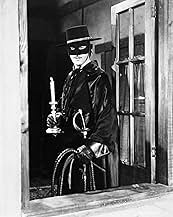Don Diego de la Vega se opõe aos tiranos corruptos da Califórnia espanhola como o espadachim mascarado.Don Diego de la Vega se opõe aos tiranos corruptos da Califórnia espanhola como o espadachim mascarado.Don Diego de la Vega se opõe aos tiranos corruptos da Califórnia espanhola como o espadachim mascarado.
Explorar episódios
Enredo
Você sabia?
- CuriosidadesDuring the two year lawsuit between Disney and ABC that halted the series production, Disney kept Guy Williams on full salary.
- Erros de gravaçãoThe "avisos" or "Wanted" posters invariably announce the reward in "pesos". Although this brings to memory the post-independence Mexican peso, the name "peso" ("peso duro", etc) was used for centuries in the Spanish colonies for the Spanish Real or "piece-of-eight", and California was not an exception.
- Versões alternativasAlso available in a computer colorized version.
- ConexõesEdited into O Signo do Zorro (1958)
Avaliação em destaque
It is 1820 and a ship approaches the coast of Spanish California with young Don Diego de la Vega returning to his father's hacienda in the pueblo of Los Angeles. Recalled home after 3 years at University in Spain, Diego learns from the Capitan that the trouble his father hinted at in his letters is due to the political oppression of the new Commandante, Capitan Monastario. Realizing that he cannot hope to fight the soldiers as himself, Diego decides that "if one cannot wear the skin of the lion, put on that of the fox." By day he will appear to be a lazy, bookish, pacifist dandy. By night he will don the black clothes, a cape, and a mask and become the "Friend of the People", El Zorro, the Fox.
Although "Zorro" aired in the early days of television in B&W, it retains a fresh, modern quality, especially in the colorized version. In one half-hour show we get plot, action, comedy, drama, music, and even Spanish dancing. Everything was done under the guidance of Walt Disney and director Norman Foster with attention to detail, high production values, and Spanish flavor. The cast was wonderful, especially Henry Calvin as Sgt. Garcia, Gene Sheldon as the "deaf"-mute servant, Bernardo, George L. Lewis as Don Alejandro, Don Diamond as Cpl. Reyes, and co-star Britt Lomond as the evil Capitan Monastario. The author and inventor of Zorro, Johnston McCulley felt that the pages of his books had come to life in this show. Guy Williams, in the dual role of Diego/Zorro will never be surpassed as either. He remains for a generation of Babyboomers the real Zorro.
"Zorro" airs nightly on the Disney Channel. The 78 episodes are shown alternately all in B&W and then again in the colorized version. Even today it remains my favorite program on television.
Although "Zorro" aired in the early days of television in B&W, it retains a fresh, modern quality, especially in the colorized version. In one half-hour show we get plot, action, comedy, drama, music, and even Spanish dancing. Everything was done under the guidance of Walt Disney and director Norman Foster with attention to detail, high production values, and Spanish flavor. The cast was wonderful, especially Henry Calvin as Sgt. Garcia, Gene Sheldon as the "deaf"-mute servant, Bernardo, George L. Lewis as Don Alejandro, Don Diamond as Cpl. Reyes, and co-star Britt Lomond as the evil Capitan Monastario. The author and inventor of Zorro, Johnston McCulley felt that the pages of his books had come to life in this show. Guy Williams, in the dual role of Diego/Zorro will never be surpassed as either. He remains for a generation of Babyboomers the real Zorro.
"Zorro" airs nightly on the Disney Channel. The 78 episodes are shown alternately all in B&W and then again in the colorized version. Even today it remains my favorite program on television.
- Jill-30
- 16 de mar. de 1999
- Link permanente
Principais escolhas
Faça login para avaliar e ver a lista de recomendações personalizadas
- How many seasons does Zorro have?Fornecido pela Alexa
Detalhes
- Tempo de duração30 minutos
- Cor
- Mixagem de som
- Proporção
- 1.33 : 1
Contribua para esta página
Sugerir uma alteração ou adicionar conteúdo ausente













































